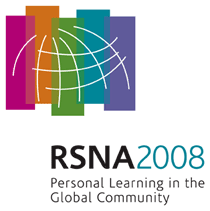
Abstract Archives of the RSNA, 2008
Luca Maria Sconfienza MD, Presenter: Nothing to Disclose
Francesca Lacelli MD, Abstract Co-Author: Nothing to Disclose
Giovanni Serafini MD, Abstract Co-Author: Nothing to Disclose
Giacomo Garlaschi MD, Abstract Co-Author: Nothing to Disclose
Enzo Silvestri MD, Abstract Co-Author: Nothing to Disclose
Plantar fasciitis is a very common disease. Shockwaves are commonly used but, currently, no widely-accepted therapy has been estabilished. The purpose of our work is to describe our technical and therapeutic approach to US-guided percutaneous treatment of plantar fasciitis.
44 patients with clinical and US diagnosis of plantar fasciitis unresponsive to medical therapy were treated. The procedure was performed by two expert radiologists. After the injection of a small amount of local anaesthetic, we performed a dry-needling on the insertional portion of the plantar fascia and on the periostium to produce local phenomena of hyperaemia. Then the needle is retracted to reach the perifascial soft tissues and a small amount of steroid (1 ml of Triamcinolone acetonide 40 mg/ml) is injected. After the treatment, a orthotic soft arch support to relieve the hind part of the foot is suggested. All the patients were followed-up clinically after the treatment for 4-6 months.
In 39/44 patients we have observed a complete disappearance of symptoms after 2-3 weeks from the treatment. In 3/44 patients we have observed a relative worsening of symptoms in the first days after the treatment, followed by a progressive reduction and a disappearance of symptoms in about three weeks. In 2/44 patients we have observed no significant response to the therapy.
US-guided treatment of plantar fasciitis is a non invasive and successful technique that allows to be more precise when injecting the steroid, avoiding the fascia. The dry-needling performed on plantar fascia and on periostium produces a local hyperemia that can be compared to a surgical debridement. The procedure is quicker, cheaper and not painful if compared to shockwaves.
This therapy is quicker, cheaper and easier if compared to shockwaves, that require at least 3 applications and are extremely painful for the patient.
Sconfienza, L,
Lacelli, F,
Serafini, G,
Garlaschi, G,
Silvestri, E,
What’s New in the Treatment of Plantar Fasciitis: A Percutaneous Ultrasound (US)-guided Approach. Radiological Society of North America 2008 Scientific Assembly and Annual Meeting, February 18 - February 20, 2008 ,Chicago IL.
http://archive.rsna.org/2008/6019569.html

